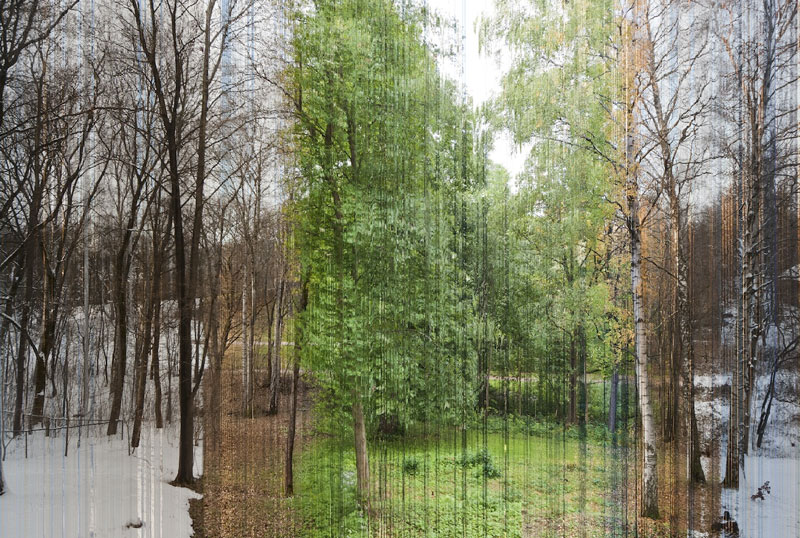What an interesting way to show a year: Norwegian hacker [Erikso] created a condensed timelapse that shows a year in a single photo. He had taken a timelapse of the view from his living room window in the frozen north every day during 2010, using a camera that was locked in place taking an image every 30 minutes. Then, with the help of some hacker friends, he came up with a script that slices these images up and combines them so that each day is represented by a vertical slice. The result is a gorgeous image that gives a wonderful sense of the seasons, and how that affects the trees. You can see the leaves grow and fall, and the snow on the ground come, go and come again.
The script that he used was written by Aslak Hellesøy and is a simple shell script that calculates the slices required and uses CLI tools from Imagemagick to slice and dice the images, then paste them together into the final image. He also put together a video from the same images. Personally, I prefer the single image.
















The images are all taken during daylight, how were night time snaps filtered out, by hand ?
Evidently:
So I selected 3888 images snapped during the day.”
The selection could have been done automatic by a script that finds the average brightness by shrinking the image down to 1 pixel text file (hue, saturation, Brightness, alpha) . And any image that are below a certain brightness level are moved into a night-time folder, and all other images are moved to a daytime folder.
(ref: https://stackoverflow.com/questions/7935814/how-to-determine-if-image-is-dark-high-contrast-low-brightness )
Or use a script to pick an image slice that’s most compatible with the slice from the day before.
I suspect each image has a timestamp, probably in the file name. It wouldn’t be that tricky to write a script to check against the sunrise and sunset times.
Nice idea, so something like this for the sunrise and sunset times.
https://stackoverflow.com/questions/2637293/calculating-dawn-and-sunset-times-using-pyephem
You might like to take a look at the sunrise/sunset timer stuff I did a while back … https://hackaday.io/project/2126-sunset-and-sunrise-camera-controller
Dark streaks are cloudy days vs. sunny days. It would nice to do clear sunny days only, at same time of day
Yup, I did about the same recently. Except the camera was a 5mpix Mobotix security camera which took photos of a construction site for a year. Then I combined photos taken between 6.30am-5.30pm but it was uneasy to watch; half cloudy days on summer, dark mornings & afternoons on winter. Luckily AfterEffects (trial) has this “CC Widetime” plugin which smoothed frames nicely… it’s a bit dreamy looking but not causing epileptic seizures.
It’s somewhat unfortunate though that while resolution is full-HD, compression quality is somewhere around QCIF – it’s all washed out square macro-blobs…
That may be a youtube artifact. I’ve uploaded a few time lapses that Youtube improved worse for me. They looked fine until Mr U Tube got his mitts on them.
He should make a bunch of these, with each one shifting the splicing over one more pixel and therefore shifting the seasonal change over one more pixel. He can then combine them into a gif or video, and you get to watch every part of the image go through the seasons as they carousel around.
The twiggs and trunks ‘whipping’ up/down must be the additional load of rain on the leaves.. looks cool.
This, i was wondering what it was, guess you could be right with it being rain. At any rate i found the video cooler then the picture because of these movements and other small changes that cant be seen in the picture for obvious reasons
Very slick. For people without the means to take their own sequence of photos, webcams and scripts come in handy.
I have a script that gloms images from the Kempten (Bavaria) Webcam. Once I had a complete year I did some processing with ImageMagick. For each month I created a sequence of frames that merged a set of adjacent images. This had the effect of filtering out highly transient activity (such as cars and people) while emphasizing weather and lighting. These frames were then turned into video.
I then used these to create a master video to accompany my instrumental track, “Kempten.”
https://vimeo.com/109284816
Each sub-video is a whole month. It starts with January, gradually adding another month. As the song track progresses, the early months drop out. At the end is just December, ending on New Years Eve.
May i ask how someone from AZ does even know about Kempten, besides making a song and video about it? Nice! Greets from Munich.
My wife is from Kempten, and I’ve visited a number of times. Es ist sehr schön dort. As is Munich! (But my German is still pretty weak.)
Very nice art-science crossover. If he was to do it again for an exhibition I’d suggest a full 360 degree pan at solar noon for each slice then mount the image as a poser print on the inside of a large cylinder, or use projection to get the same immersive effect of being within the landscape and having direction corresponding to the seasons. A few exposure tricks could help to smooth out exposure variations caused by moving clouds, also blending between strips, but the visible slices are an aesthetic issue anyway so that is the artists call.
Surely there is funding available for projects like this? The prototype is a winner in itself so it should get funded.